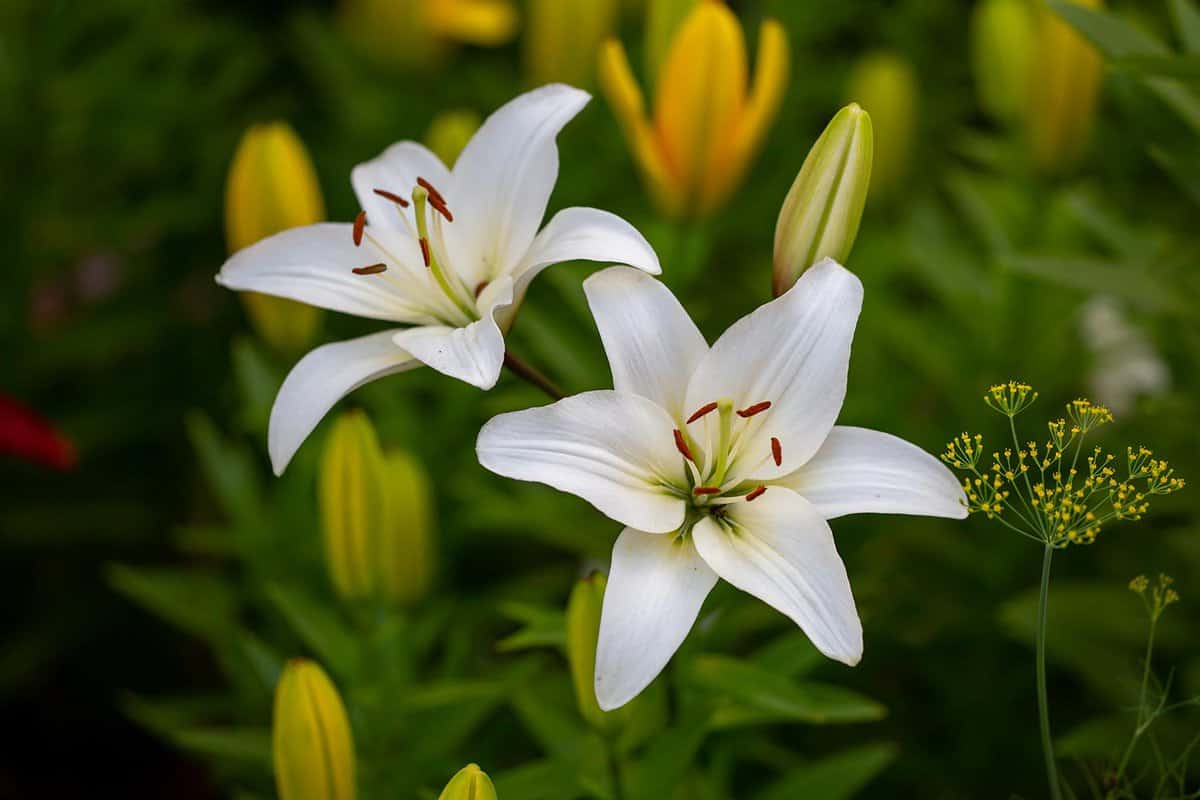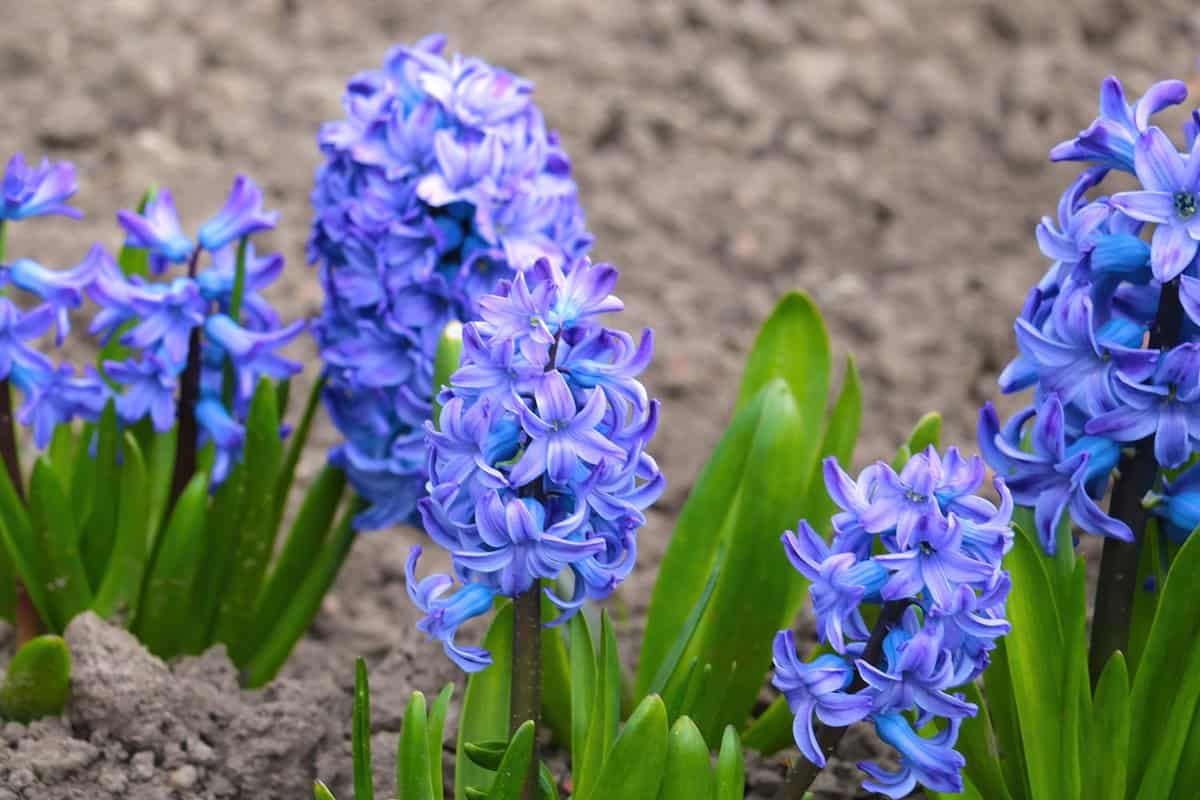Plants can be very particular about the conditions under which they grow. If you live in zone 5 and have a sunny spot for your garden, you might wonder which perennials like to grow in full sun. We've researched to bring you some options.
Countless perennials do well and even prefer full sun. Here are ten examples:
- tulips
- delphinium
- purple coneflowers
- bee balm
- peony
- lilies
- lavender
- hyacinths
- salvia
- hollyhock
While some of these perennials are well-known, you may not be as familiar with others. We will describe each of these plants and give you information on how to grow them successfully.

Perennials That Enjoy Full Sun
While each of these perennials enjoys full sun, many do very well in partial sun. One thing they all have in common is that they require well-drained soil.
1. Tulips

Because tulips come in various colors, they make beautiful additions to rock or flower gardens. You can also harvest them and put them on display inside your home.
Planting And Care
Tulip bulbs should be planted in the fall to bloom in the spring. If you stagger your planting times, you can enjoy new blooms all spring. Bulbs should be planted in groups of ten or more to yield a more beautiful display when they bloom.
Miracle-Gro advises that tulips should be watered once a week for the first month. They should not be watered again until they bloom in the spring.
Considerations
The Almanac warns that wildlife such as rabbits and squirrels enjoy tulips, so be sure to take preventative measures to keep animals away from your flowers.
Learn where to buy your tulip bulbs online by checking out "Where to Buy Tulip Bulbs? [Top 40 Online Stores]."
2. Delphinium

There are over 300 species of delphinium, but only those from the elatum and belladonna groups are perennials. Delphinium plants attract bees, hummingbirds, and butterflies, making them a good choice for pollinator gardens.
Planting And Care
Delphinium plants need to be planted in spring and will bloom in summer and fall. Because some varieties grow up to six feet tall, they often need supports installed in early spring when they reach a height of twelve inches.
Considerations
Delphinium is highly toxic to animals and humans. Avoid planting them if you have young children, pets, or grazing animals on your property.
Take a look at "When To Transplant Delphiniums [And How To]" to learn about transplanting delphiniums.
3. Purple Coneflowers

Also known as echinacea, these plants are edible and often used in medicinal remedies. They also attract bees and other pollinators, so they are useful plants to have in your garden.
Planting And Care
Water purple coneflowers daily when they are planted and then once per week. While they should be watered regularly, they are drought-tolerant and don't do well in humid or very rainy areas. Purple coneflowers will tolerate partial shade but don't grow as well as in full sun.
Considerations
These plants attract insects such as Japanese beetles, aphids, and leafhoppers. Consider applying garden-safe pesticides to keep them pest-free.
4. Bee Balm

Some people may know bee balm better than wild bergamot. As its bee-themed name suggests, bees and other pollinators enjoy this plant, so it does well in a pollinator or butterfly garden.
Planting And Care
Plant bee balm in spring or fall, and be sure to water it when planted. Blooms occur in mid to late summer. Bee balm plants must be divided and re-planted every 2-3 years in the spring.
Considerations
Bee balm needs good air circulation to prevent mildew from growing. If you notice mold on your plants, water them less often.
5. Peony

Peonies come in various types and colors, so you can choose the perfect ones for the look you are trying to achieve. Many people enjoy planting them along walkways; you can even harvest some to decorate your home.
Planting And Care
Fall is the best time to plant peonies, and they will bloom in late spring to early summer. Peonies are easy to care for but require certain conditions to thrive.
They do not transplant well, so if you need to move them, be sure to do so in the fall when the plant is dormant. Since peonies are top-heavy after blooming, they need shelter from strong winds, but they enjoy full sun, so they cannot be planted too close to trees or shrubs that will shade them too much.
Considerations
Since ants enjoy peony nectar, they will be attracted to your plants. They are not pests and will not cause any harm to your peonies. Plant the peonies away from your home, however, so the ants don't make their way inside and become household pests.
6. Lily

While there are many varieties of lilies, the Asiatic and oriental lilies are the most popular perennial varieties. They are known for their stronger fragrance and look beautiful outdoors in gardens and indoors as cut flowers.
Planting And Care
Lilies must be planted in the fall, about four weeks before the first frost. If you live in an area with harsh winters, you can plant them in the spring instead. Mix varieties with different bloom times to get continuous blooms from early summer through fall.
Water them freely while growing, then keep them moist but not too wet. They enjoy growing in mulch and prefer acidic to neutral soil. Like all perennials, the ground needs to be well-draining.
Considerations
Lilies are susceptible to grey mold. Be sure not to overcrowd them so air can circulate around them. Lilies also attract wildlife such as deer, rabbits, and groundhogs. Consider protecting your lily plants with netting or fencing to prevent them from being eaten.
7. Lavender

Because there are so many ways to use lavender, it will come in handy both in your garden and after harvest. Many use lavender for aromatherapy, health benefits, and homemade skin and body care.
Planting And Care
Plant lavender in the spring after the threat of frost has passed in your area. It is easier to grow lavender from a young plant than from a seed, so you may want to purchase pre-started plants from your local garden center or nursery.
Lavender must be watered once to twice a week until it is established. Then, you can reduce watering to every 2-3 weeks until buds begin to form. Return to watering once to twice a week after buds form until you are ready to harvest it.
Considerations
Lavender can fall victim to various fungi, bacteria, and pests. Keep your plants well-maintained and remove any diseased or infested plants as soon as possible to prevent spread. Planting the lavender in mulch can help keep weeds to a minimum.
8. Hyacinth

Hyacinths come in various colors and are called "nature's perfume" because of their incredible fragrance. Like some of the other flowers on our list, hyacinths are beautiful in the garden and can be harvested as a cut flower for indoors.
Planting And Care
The first year you plant these, bulbs should be planted in the fall. Each subsequent fall, remove old bulbs past their prime and plant fresh bulbs. Blooms will appear in mid-spring. For the best look, plant bulbs in groups of 5-9.
Considerations
Hyacinths need a period of cold temperatures to thrive. If your area does not get at least 12-14 weeks of temperatures that are 40-45 degrees, hyacinths are not the right perennial to add to your garden.
9. Salvia

You may not be familiar with salvia, but you may know a bit about sage, the family from which salvia comes. The garden-variety sage you may use in recipes is one of 900 different salvia species. In addition to the kitchen uses of some types of salvia, it also attracts butterflies, so it is a perfect addition to your pollinator garden.
Planting And Care
Plant your salvia in the spring after the danger of frost has passed. Salvia does well in any soil as long as it is well-draining. These plants are drought tolerant and do not require a lot of water. It is best to water them as little as possible to prevent root rot.
Considerations
Salvia plants deter deer and rabbits, so planting them in your garden is a beautiful way to protect any plants that attract wildlife.
10. Hollyhock

Hollyhock flowers have an old-time charm that may send you back to memories of your childhood. They come in various colors, so you can easily add these nostalgic and graceful flowers to any garden look.
Planting And Care
Plant your hollyhock seeds a week before your area's last frost, and you can enjoy their blooms from June through August. While hollyhock is drought tolerant, it is ideal to water them regularly, avoiding their foliage when watering. Pay close attention as they begin to grow. They may need support added due to their height.
Considerations
Take care when handling your hollyhock plants. The tiny fibers that cover their stems and leaves can cause skin irritation.
Hollyhock is prone to a fungal infection called hollyhock rust. Remove the parts of the plant that have hollyhock rust, so it doesn't spread. You will notice yellow spots on the leaves as the first sign of this infection. As it progresses, brown-colored bumps will form on the undersides of the leaves.
Summary
If you live in gardening zone 5, you have a wide variety of perennials that will thrive in your garden. Follow planting directions and suggestions to help you create the garden of your dreams.
